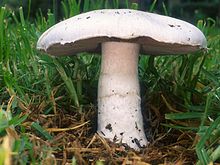Agaricus campestris
| Agaricus campestris | |
|---|---|

| |
| Scientific classification | |
| Domain: | Eukaryota |
| Kingdom: | Fungi |
| Division: | Basidiomycota |
| Class: | Agaricomycetes |
| Order: | Agaricales |
| Family: | Agaricaceae |
| Genus: | Agaricus |
| Species: | A. campestris
|
| Binomial name | |
| Agaricus campestris L. (1753)
| |
| Agaricus campestris saprotrophic | |
|---|---|
| Edibility is choice | |
Agaricus campestris is a widely eaten gilled mushroom closely related to the cultivated A. bisporus (button mushroom). A. campestris is commonly known as the field mushroom or, in North America, meadow mushroom.
Taxonomy
This species was originally noted and named in 1753 by
The
An analysis of ribosomal DNA of a limited number of members of the genus showed A. campestris to be an early offshoot in the genus and sister taxon to A. cupreobrunneus.[3]
Description
The
Similar species
Several species may be confused with A. campestris. The most dangerous confusion may be with the deadly Amanita virosa (the destroying angel),[7] or with the deadly Amanita hygroscopica (the pink-gilled destroying angel).[8] In the US, it may be confused with the poisonous Agaricus californicus[4] or A. hondensis. White Clitocybe species that also grow in grassy places may be toxic. According to Moldenke, some authorities believed that the mandrakes referenced in Genesis and in Song of Solomon were not Mandragora Officinarum L, but instead might be Agaricus campestris L.[9]
A less serious, but more common, confusion is with Agaricus xanthodermus[7] (the yellow stainer), which causes gastrointestinal problems in many people. A. arvensis (the horse mushroom) is similar and an excellent edible.
Distribution and habitat
A. campestris is found in fields and grassy areas after rain from late summer onwards worldwide. It is often found on lawns in suburban areas, appearing in small groups, in
The mushroom has been reported from Asia, Europe, northern Africa, Australia,[12] New Zealand, and North America.[13][14]
Uses
Although edible and choice,[4][15] this mushroom is not commercially cultivated on account of its fast maturing and short shelf-life.[16] Culinary uses of the meadow mushroom include eating it sauteed or fried, in sauces, or even sliced raw and included in salads. In flavor and texture, this mushroom is similar to the
It is nearly identical (except microscopically) to the edible species Agaricus andrewii and A. solidipes.[17][18]
Other uses
Research into fungal dressings for the treatment of ulcers, and bed sores, using fungal mycelial filaments, is ongoing.[citation needed] In the past, slices of A. campestris were applied to scalds and burns in parts of Scotland.[19]
Bioactive properties
Water extracts of A. campestris have been shown to enhance the secretion of
See also
- List of Agaricus species
Gallery
-
Free hymenium (spore producing tissue layer) (also referred to as gills) of Field Mushroom
References
- ^ Linnaeus C. (1753). Species Plantarum (in Latin). Vol. 2. Stockholm: Lars Salvius. p. 1173.
- ISBN 978-0-8131-9039-6.
- S2CID 40265528.
- ^ OCLC 797915861.
- ISBN 978-0-14-063006-0.
- ISBN 978-0-7627-3109-1.
- ^ ISBN 978-1-4930-2669-2.
- ^ "Amanita hygroscopica - Amanitaceae.org - Taxonomy and Morphology of Amanita and Limacella". www.amanitaceae.org.
- ^ Moldenke, Harold N., and Alma L. Moldenke. “132. Mandragora Officinarum L.” Essay. In Plants of the Bible, 137–39, 283. New York, NY: Kegan Paul, 2002.
- .
- ^ Mabey R. (1972). Food For Free, A Guide to the Edible Wild Plants of Britain. Fontana/Collins.
- ^ J. H. Maiden (1889). The useful native plants of Australia : Including Tasmania. Turner and Henderson, Sydney.
- ISBN 978-0-226-72117-0.
- PMID 24597704.

- ISBN 978-0-7627-3109-1.
- ISBN 978-0-14-046273-9.
- ISBN 978-1-55407-651-2.
- ^ Murrill, William (1922). "Dark-Spored Agarics". Mycologia. 14. New York Botanical Garden: 203.
- ISBN 978-0-00-728464-1.
- PMID 9659289.


